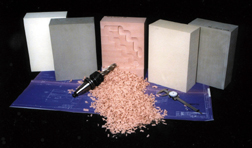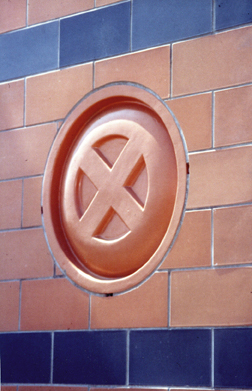|
Polyurethane Tooling and Model Planks: Characteristics and Applications
Architect Louis I. Kahn once said, "Even a brick
wants to be something." This is just as true now as
rigid polyurethane modeling and tooling-board
products become important media in product design and
rapid-manufacturing technologies. These synthetic materials
are playing an ever-larger part in manufacturing and
new-product design.
 Like bricks, tooling boards are vital building blocks in creating
new things to fill our needs. Advances in polymer chemistry,
tool-making technologies and CAD/CAM processes
have focused greater attention on these materials.
Like bricks, tooling boards are vital building blocks in creating
new things to fill our needs. Advances in polymer chemistry,
tool-making technologies and CAD/CAM processes
have focused greater attention on these materials.
Historically, designers and tool-makers would craft their
products from wood. Due to the increasing scarcity of
high-quality wood stock, rising costs and the difficulties
and health dangers associated with the use of wood, this
practice is changing. While wood has been commonly
available and plentiful for centuries, the requirements of
21st-century industry are sidelining its use in tooling and
design-modeling.
A natural product, wood often contains inconsistencies
and defects (grain effects, knots, wane, checking, splits)
affecting performance in cutting and (especially) CNC-machining
operations, resulting in longer machine-times
and higher costs.
Even special, select-grade wooden pattern boards
contain tannins and mold-spores, potential health-hazards
released in cutting operations. Wood is also susceptible to
dimensional changes due to its affinity for water and its
isotropic grain-structure. With designers and tool-makers
needing fast processing, tighter tolerances and reliable
dimensional stability in prototyping and manufacturing
operations, the correct synthetic material often out-performs
what Mother Nature provides.
Machineable waxes and modeling clays are also used
for design exercises. While they are recyclable, they are
impermanent, difficult to paint or finish, and sometimes
messy to use. Have a dropped tool inadvertently
strike a surface, or have a really warm day in the shop,
and important details can be lost. Tooling boards,
while not recyclable, are more durable and compatible
with CNC processes.
Pioneering work in polyurethane tooling boards was
done by Ciba-Geigy in the mid-1980s, with board materials
to facilitate design and installation of heat-insulating
tiles on the Space Shuttle. Since then, this "space-technology"
has spread into almost every business needing to
design or manufacture tangible objects from concept-cars
to soles for sport shoes.

Today, several manufacturers produce rigid synthetic
boards for prototyping, styling and tooling
applications. While they are more costly than wood
on a per-unit cost basis, the advantages of using
tooling board materials lower total project costs to
very reasonable levels. Tooling-boards are generally
classified by density; encompassing a wide range
of options, from medium-density foams to very
dense, solid-plastic planks. This allows users to
match materials to job requirements while controlling
costs.
Some tooling boards are syntactic foams, where
very small glass or plastic bubbles are mixed with
resin to create a specific-density block. Other boards
are expanded foams, where carbon-dioxide gas, a
by-product of chemical reactions, makes cells to
create a specific density. Both manufacturing methods
render consistent boards with no voids, uniform
density and predictable processing characteristics.
While each tooling-board type has its special use,
there are several common advantages that distinguish
them from alternatives:
- Ease of Machining Because boards are consistent,
uniform and grain-free, concerns with
cutting-direction, tear-out and warping are few.
Faster CNC-machine spindle speeds and material
feed-rates are possible, increasing productivity.
Manufacturers offer advice on cutters, spindle-
speed and feed-rates for their materials.
- Shop Safety Most board products create shavings
when cut, and many contain anti-static additives for
reduced shop dust on the floor and in the air.
- Dimensional Stability Boards are closed-cell, and
predominantly polyurethane-based, making them relatively
insensitive to humidity changes. Thermoset
polyurethane polymer has predictable thermal expansion
characteristics. Good processors treat their boards
to remove residual stresses, eliminating warping.
- Temperature Resistance Most boards are useful up
to 150 degrees F, with many usable at temperatures of
210-225 degrees F. Some boards can be processed
repeatedly at 250 degrees F.
- Larger Block Sizes available Some manufacturers
offer shapes up to 12" thick, and up to 48" x 96" in
length and width, greatly reducing glue-up labor in
build-ups. This is a tremendous advantage over wood
products, especially as fully-loaded model-shop labor
costs reach $50.00 per hour and more.
- Easily Bonded and Repaired Many manufacturers
offer specific adhesives and patch compounds for tooling
boards, matched to particular grades.
- Easy Surface Finishing Almost all of these products
accept a wide-range of coatings and finishes. Small cell-sizes
give very good (to excellent) finished surface
results. It is possible, with electroless-plating processes,
to create polished-metal surfaces on prototypes made
with tooling boards and foams.
Density Ranges
Each density-range
of tooling
board has typical
applications. None
of these suggestions
are hard-and-fast
rules. Instead, use
them as starting
points for
consideration
in using
tooling
boards in
manufacturing
operations.
Keep in
mind: Higher
Density =
Higher Cost.

- High-density boards (>30 lbs. per cubic foot)
are used where manufacturing stresses are high,
or where exact dimensional tolerances, sharp-corner
retention and excellent surface-finish is
important. Vacuum-bag tools, thermoforming
molds, hydroforming tools, check-fixtures, foundry
patterns, trim-fixtures and highly-detailed
models or prototypes benefit from use of this
grade of tooling board.
- Medium-density boards (<30 lbs. per cubic
foot) are useful for styling applications, mold-patterns
and CNC-program proofing. Fine-detail
rendering and surface-finish quality is not as
good as boards that are denser, but adequate
for many purposes at a reduced cost. Detroit
automakers create entire concept cars with tooling-
boards in this density range. Forming tools
for acrylic plastics, low-rate and prototype thermoforming
tools, and molds for low-temperature-
curing pre-pregs are also made with these
materials.
- Low-density boards
(<15 lbs. per cubic foot)
Really high-density foams, these are used for
quick design studies when hand-carving is easier
and less expensive than CNC programming and
machining. Used for sight models, theme-park
characters, architectural studies, or topographical
maps, these boards are very low-cost. Automotive
design-houses (with large-envelope CNC routers)
will sometimes craft prototype car-body styles
directly from CAD programs using foam.
The table below gives more suggestions for potential tooling-board applications.
|
Tooling Board Selection Guide
|
| Application | Suggested Board Density |
|
| <15
lbs. cu. ft. | | 15 to 30 lbs. cu. ft. | | 30 to 50 lbs. cu. ft. | | 50 to 80 lbs. cu. ft. |
Design Prototypes |
X |
| X |
|
|
|
| Appearance, Styling or “Sight” Models |
X |
|
X |
| |
| |
| Architectural Models, Topographical Maps |
X |
| |
| |
|
| Master Models |
|
| X |
| X |
| X |
| Trims, Jigs and Fixtures |
|
| X |
| X |
| X |
|
| Thermoforming Tools, Autoclave Tools |
X |
| X |
| X |
| |
| Foundry Patterns |
|
| |
| X |
| X |
|
| Mold Patterns |
X |
| X |
| |
| |
| Dimensional Check-fixtures |
|
| |
| X |
| X |
|
Molds for low-temperature casting
(<200° F) seal surfaces before use |
|
| X |
| X |
| X |
| CAD Model Proofs/NC Program Proofs |
X |
| X |
| |
| |
|
|
| Molds for low-temperature curing pre-pregs (<200° F) seal surfaces before use |
|
| X |
| X |
| X |
So even tooling boards "want to be something" and
increasingly, these highly developed model and design
materials are gaining their wish. Modern synthetic tooling
boards offer significant advantages over wood products,
and other media. While more costly to acquire, the over-all
system-cost of using tooling boards is less. Savings
accrue when durability and performance can be matched
to job requirements, and labor inputs for machining, glue-up
and finishing can be reduced, all while delivering
attractive and functional results.
Contributed by Ted Hile, Market Development Manager
for General Plastics Manufacturing Co., manufacturers
of LAST-A-FOAM® rigid high-density polyurethane foams
for composite core, thermoform and mold tooling, styling
models and prototypes. Hile has 12 years of experience
in the polyurethane foam industry, with specialization in
aircraft/aerospace, defense and tooling applications.
For more information, contact General Plastics at
253-473-5000, Fax: 253-473-5104, E-mail: sales@
generalplastics.com, Web: www.generalplastics.com.
|